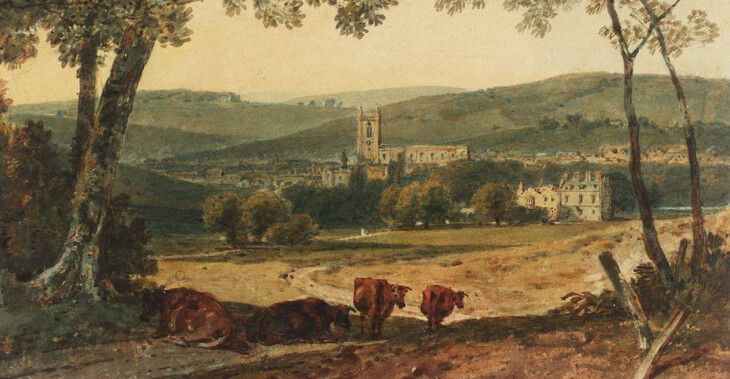From the entry
This section contains High Wycombe from the Marlow Road, the only watercolour in Tate’s Collection related to Turner’s involvement in Britannia Depicta, a publication by the British engraver, William Byrne (1743–1805). Byrne had intended for Britannia Depicta to comprise of engravings of illustrations by topographical artists of picturesque views in every country in Great Britain, and it was to serve as a companion to the much larger topographical survey by the Reverend Daniel Lysons and his father Samuel, entitled Magna Britannia: or a Concise Topographical Account of the Several Counties of Great Britain. Among the established artists involved were William Alexander (1767–1816), Joseph Farington (1747–1821), Thomas Hearne (1744–1806) and John ‘Warwick’ Smith (1749–1831). However, due to a lack of subscribers or the overambitious nature of the project, the publication was cancelled with only four volumes having been ...
This section contains High Wycombe from the Marlow Road, the only watercolour in Tate’s Collection related to Turner’s involvement in Britannia Depicta, a publication by the British engraver, William Byrne (1743–1805). Byrne had intended for Britannia Depicta to comprise of engravings of illustrations by topographical artists of picturesque views in every country in Great Britain, and it was to serve as a companion to the much larger topographical survey by the Reverend Daniel Lysons and his father Samuel, entitled Magna Britannia: or a Concise Topographical Account of the Several Counties of Great Britain. Among the established artists involved were William Alexander (1767–1816), Joseph Farington (1747–1821), Thomas Hearne (1744–1806) and John ‘Warwick’ Smith (1749–1831).1 However, due to a lack of subscribers or the overambitious nature of the project, the publication was cancelled with only four volumes having been printed.2 Consequently, only engravings illustrating the counties of Bedfordshire, Berkshire, Buckinghamshire, Cambridgeshire, Cheshire, Cornwall and Cumberland were published.
For this project, Byrne commissioned seven preliminary watercolour designs from Turner, of which High Wycombe from the Marlow Road, catalogued here, was purchased by Tate as part of the Oppé Collection in 1996 (Tate impression of the 1803 engraving: T05940). The other subjects were Chester Castle3 (engraved 1810: T05948) which is at the Ashmolean Museum, Oxford, and Abingdon, from the Thames Navigation4 (engraved 1805: T05942, T05945) at the Courtauld Gallery, London. Donnington Castle5 (engraved 1805: T05946, T05947) is in a private collection and the location of Newbury, from Speen Hill6 (engraved 1805: T05945) is unknown. The final two preliminary watercolours, Chester – a Distant View7 (engraved 1810: T05730) and Eton, from the Slough Road 8 (engraved 1803: T05941) resurfaced at auction in 2014, though their current whereabouts is unknown.9
Turner scholar Anne Lyles has commented that Byrne’s engravings ‘are rather hard and scratchy and fail to do justice to Turner's original designs.’10 She also suggested that this may have influenced Turner, in later years, to take a supervisory role when training engravers so that his preliminary watercolour sketches were translated with ‘much greater sensitivity and skill.’11
At the time of this publication, Turner had established his reputation as an artist, and in 1802 he became a full member of the Royal Academy. This elevation in status is acknowledged in the inscription of the High Wycombe engraving.12 During this period of his career, Turner’s disinclination with the ‘conventional and prescriptive’13 nature of the picturesque is evident as his style becomes more experimental and ‘concerned with meaning and the expression of feelings and ideas in a rather literal sense’.14 In a draft for his first lecture at the Royal Academy, he wrote ‘the main object to attain in art ... is a just perception of what is beautiful in nature’.15
See Anne Lyles in Lyles and Robin Hamlyn, British Watercolours from the Oppé Collection, with a Selection of Drawings and Oil Sketches, exhibition catalogue, Tate Gallery, London 1997, p.190.
‘Britannia Depicta: a series of views with brief descriptions of the most interesting and picturesque objects in Great Britain’, rct.uk, accessed 15 September 2023, https://www.rct.uk/collection/1076098/britannia-depicta-a-series-of-views-with-brief-descriptions-of-the-most ; for accounts in relation to Turner, see W[illiam] G[eorge] Rawlinson, The Engraved Work of J.M.W. Turner, R.A., vol.I, London 1908, pp.28–31, Andrew Wilton, J.M.W. Turner: His Life and Work, Fribourg 1979, pp.334–5, Luke Herrmann, Turner Prints: The Engraved Work of J.M.W. Turner, London 1990, p.23, and Lyles 1997, p.190.
Sotheby’s. London, 9 July 2014 (lots 223 and 224); catalogue entries at Sotheby’s, accessed 24 April 2024, https://www.sothebys.com/en/auctions/2014/old-master-british-drawings-l14040.html .
How to cite
Vanessa Otim, ‘‘Britannia Depicta’ Watercolour c.1802’, April 2024, in David Blayney Brown (ed.), J.M.W. Turner: Sketchbooks, Drawings and Watercolours, Tate Research Publication, September 2024, https://www


